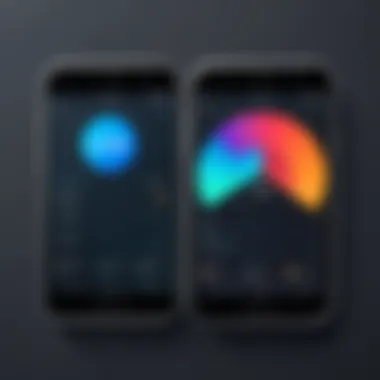Top Video Apps for Samsung Devices Reviewed


Intro
In the fast-evolving world of mobile technology, video apps have become essential for users, especially for those with Samsung devices. Samsung's extensive line of smartphones and tablets allows for superior video playback and streaming experiences, but choosing the right video app can be a daunting task. With a plethora of options available, it is crucial to consider various factors that significantly influence user experience. This article aims to guide Samsung device owners in selecting the best video app tailored to their preferences and needs.
By exploring different aspects, from technology features to user interface design, this article provides a holistic view to make an informed decision. Understanding what makes these apps stand out ensures you can enjoy video content to its fullest on your Samsung device.
Overview of the Technology
Key Specifications
The performance of video apps largely hinges on their technological specifications. Most of the top apps support a wide array of video formats, ensuring that users can play everything from standard-definition to high-definition content. Also, many apps offer features such as adaptive bitrate streaming that adjusts the video quality in real-time based on your internet speed, providing a seamless viewing experience.
Unique Selling Points
Among the key features that differentiate video apps are their integrations within the Samsung ecosystem. Apps like Samsung Video Player or YouTube harness aspects of Samsung's hardware capabilities, such as hardware acceleration, enabling smooth playback. Furthermore, several apps offer personalized recommendations, enhancing user engagement.
"The right video app can transform your Samsung device into a portable cinema, elevating the user experience to new heights."
Additionally, the availability of offline playback is a vital factor. Apps like Netflix and Amazon Prime Video allow users to download content for later viewing, which is crucial in scenarios with limited internet access.
Design and Build Quality
Material Used
While software is key for performance, the design and user interface of a video app is equally important. Quality video apps often utilize modern design principles with clean lines and user-friendly navigation. Apps like VLC Media Player stand out thanks to their minimalist design, which prioritizes user interaction and content consumption above all.
Ergonomics and Usability
The usability of a video app can greatly impact how users engage with the content. For example, options like MX Player offer gestures for volume and brightness control, facilitating a more interactive experience. The layout and organization of content determine how quickly users can find the videos they want to watch.
In summary, the best video apps for Samsung devices combine advanced technology with thoughtful design, ensuring that users can enjoy a superior viewing experience. Understanding these components prepares users to choose a video app that suits their needs.
Prolusion to Video Apps for Samsung
The rise of digital media consumption has made video apps essential for users of modern devices. For Samsung users, having the right video app can significantly enhance the viewing experience. These apps facilitate access to vast libraries of content, ranging from movies and documentaries to user-generated videos and live streams. Moreover, they often integrate smoothly with Samsung's unique hardware features, optimizing performance and playback quality.
In this article, we will explore various video app options specifically designed for Samsung devices. We will provide insights into their features and user interfaces. Understanding these aspects is crucial because the right choice can make a difference between a good and an exceptional viewing experience. Users must consider their individual preferences, usage habits, and the specific functionalities of their Samsung devices.
Importance of Video Apps in Modern Devices
Video apps serve an important role in this connected world. With the prevalence of streaming technology, users no longer rely solely on traditional television. They seek flexible solutions that fit their fast-paced lives. This shift has led to an explosion of video app options, each with unique characteristics.
- Here are some key areas where video apps impact user experience:
- Content Variety: Streaming apps often provide a broad range of genres. This allows users to discover new content beyond what is usually available on local networks.
- User Convenience: Video apps allow users to watch content on-demand, fitting their schedule. This flexibility is essential for today's audience.
- Interactivity: Many apps integrate social features, enabling users to share and discuss content with friends. This adds a social dimension to video consumption.
Essentially, video apps not only satisfy entertainment needs but also create a platform for personal and social engagement. As technology evolves, so too do the expectations of users. Therefore, selecting the best video app becomes critical for maximizing the enjoyment of Samsung devices.
Criteria for Selecting a Video App
Selecting the right video app for Samsung devices is a decision that can greatly influence your viewing experience. The variety of apps on the market offers distinct features, and understanding the criteria for selection is essential. Each element plays a vital role in determining which application best meets your individual needs. Here, we explore the key considerations to help you make an informed choice.
User Interface and Experience


The user interface (UI) is the first aspect you encounter when opening a video app. A clean and intuitive UI enhances navigation and makes it easier to find and enjoy content. The experience goes beyond aesthetics; it includes functional elements such as search options, layout, and responsiveness. Users prefer apps that are easy to maneuver. If an app is clunky or difficult to use, it can deter engagement. For example, platforms like YouTube offer straightforward navigation, which appeals to tech-savvy users.
It’s also important that the app adapts well to Samsung’s unique display features. It should utilize the screen’s resolution and size effectively for an optimal viewing experience. This emphasis on UI and experience ensures users can enjoy their favorite shows without unnecessary frustration.
Compatibility with Samsung Features
Samsung devices encompass various exclusive features that enhance media consumption. An ideal video app should seamlessly integrate with these features. This includes compatibility with Samsung Smart View, which allows users to stream content easily to compatible smart TVs. Additionally, the app should support features like Bixby Voice for voice search and Multi Window modes to multitask efficiently.
The integration with device-specific features means users get a more robust experience tailored to Samsung’s ecosystem. If an app lacks this compatibility, it might limit usage functionalities. Hence, choosing an app that connects well with your Samsung features amplifies usability and satisfaction.
Video Quality and Performance
Video quality is undoubtedly a critical factor when selecting a video app. Streaming in HD or higher resolutions can significantly elevate your viewing experience. Users often have high expectations regarding the clarity and fluidity of playback, especially on high-resolution Samsung displays.
Performance encompasses how smoothly the app runs without lag or buffering issues. An app like Netflix boasts adaptive streaming technology that adjusts quality based on internet speeds, ensuring a consistent experience. It is best to research app performance via reviews to understand how they perform under varied conditions.
Moreover, considerations may include support for various formats, such as MP4, MKV, or AVI, since users may have diverse content types. The combination of high video quality and reliable performance can make or break the appeal of a video app.
Top Video Apps for Samsung Devices
When it comes to selecting a video app for Samsung devices, the options are plentiful. Each app offers unique features and capabilities that can enhance the viewing experience. The right video app can make a significant difference in how users consume content. This section explores the top video apps available for Samsung devices, considering features such as streaming quality, usability, and integration with device capabilities.
Netflix
Netflix remains a leading choice among video streaming apps. Its vast library includes an array of movies, shows, and original content that appeals to a wide range of audiences. One of Netflix’s strengths is its recommendation algorithm. Users benefit from personalized suggestions based on their viewing history, making it easier to discover new titles.
Netflix provides support for high-definition streaming, which is especially important for those with Samsung devices that offer high-resolution displays. Furthermore, the app supports offline viewing, allowing users to download content. This feature is essential for those who travel or have limited internet connectivity.
YouTube
YouTube serves as a universal platform for video content, offering everything from short clips to full-length films. Its accessibility is unmatched, and the diversity of content is immense. For Samsung users, the YouTube app is optimized to work seamlessly with device features like picture-in-picture mode. This allows users to multitask while watching videos.
Another benefit is user engagement. Viewers can comment, like, and share videos, making it a social experience. While there are ads, YouTube Premium offers a subscription to remove them. For those who prioritize user-generated content, YouTube is a prime choice.
Samsung Video Player
Samsung Video Player is tailored specifically for Samsung devices. Its integration with the Samsung ecosystem allows for a seamless experience. Users can play videos from their gallery or various streaming services directly within the app.
This app supports a variety of video formats, ensuring compatibility with different file types. Additionally, its user-friendly interface provides easy access to features like subtitles and playback settings. While it may not have the extensive library of other streaming services, its primary advantage lies in its versatility and built-in system support.
Media Player
VLC Media Player is well-known for its open-source development and extensive format support. This app stands out for its ability to play nearly any video file type. For Samsung users with locally stored videos, VLC can access content without the need to convert files.
The app's interface is straightforward, focusing on functionality. Features such as playback speed adjustment and subtitle support add to its appeal. While it lacks some advanced streaming features of other apps, its ability to handle diverse media formats makes it a valuable addition.
Amazon Prime Video
Amazon Prime Video is a strong competitor in the video app arena. It offers a substantial library of movies, series, and exclusive content. A notable aspect is its integration with other Amazon services, allowing for easy access for existing Prime members. The app supports 4K and HDR streaming, which is essential for users with high-end Samsung devices.
Moreover, Amazon Prime Video includes options for renting or purchasing movies not found in the subscription catalog. This flexibility can appeal to users wanting immediate access to newly released films. The user interface is intuitive, enhancing the overall viewing experience.
The choice of video app can significantly impact how content is viewed and enjoyed on Samsung devices.


Each of these apps addresses different needs and preferences. Understanding their features helps users make informed decisions. It is crucial to assess what one values most in a video app, whether it’s a broad selection, high quality, or unique capabilities. The selection of the right app will greatly enhance the viewing experience on Samsung devices.
Comparative Analysis of Video Apps
A comprehensive comparative analysis of video apps is essential in identifying which ones stand above the rest, especially for Samsung device users. This exploration allows users to understand how various apps stack up against each other. It is more than just looking at the features; it also involves understanding the overall user experience, compatibility with Samsung's technologies, and pricing structures. The focus on this analysis ensures that users are informed decisions that fit their specific needs.
By evaluating different aspects of video apps, users can pinpoint the ones that provide the best value for their preferences. This type of detailed investigation also highlights the subtle differences that can significantly impact user satisfaction. Ultimately, the goal is to provide insights that will help maximize the video playback experience, essential for any tech-savvy individual.
Feature Comparison
When comparing video apps, features are among the largest considerations. Users should evaluate aspects such as the type of video formats supported, resolution options, and special functionalities. Some video apps may offer offline viewing, while others prioritize streaming quality or user interface polish. For example, Netflix excels in streaming options and exclusive content, whereas VLC Media Player is renowned for its diverse format support.
Key features may include:
- Supported video formats: Ensure the app handles the formats you intend to use.
- Streaming quality: Look for apps that support 4K or HDR.
- Ease of use: A well-designed user interface can enhance the watching experience.
- Social sharing options: Many video apps offer sharing features that allow users to connect with friends.
These factors must be assessed carefully. Preferences differ among users, and balance between multiple features will guide in selecting the most suitable app.
Cost and Subscription Models
Cost is a crucial aspect in choosing a video app. Different models can cater to various user preferences and budgets. Some apps operate on a subscription basis, such as Amazon Prime Video, requiring monthly or annual payments. Others may provide a free option with ads, like YouTube, or charge for premium features.
Considerations when reviewing cost and subscription:
- Subscription frequency: Monthly fees might add up, while annual subscriptions may offer discounts.
- Ad presence: Free versions may bombard users with ads, influencing overall satisfaction.
- Content library: Paid subscriptions often come with an extensive library not available elsewhere.
Understanding these models ensures users make informed choices about their investments and overall experience when using every app.
User Experience Testimonials
User experience testimonials serve a crucial role in understanding how video apps perform in real life, particularly among Samsung device users. These testimonials highlight individual experiences and preferences, providing insights that statistics and feature lists alone cannot convey. The subjective nature of personal narratives can illuminate aspects of the apps that may not be immediately apparent. For example, a user might find that a specific app works seamlessly with their Samsung Galaxy series, enhancing the overall video viewing experience.
A major benefit of reviewing user testimonials is the broad spectrum of perspectives they present. Different users have unique devices, usage patterns, and expectations; some may prioritize video quality while others seek ease of use. This diversity in feedback allows potential users to gauge how an app aligns with their specific needs. Additionally, testimonials often reveal potential drawbacks that users encountered, giving a more balanced view versus traditional marketing.
However, when evaluating testimonials, it’s essential to consider several factors. The source of the testimonial is important—reviews from established tech sites may carry more weight than anonymous comments on forums like Reddit. Similarly, a detailed review discussing particular features of a Samsung app provides more value than a vague confirmation of satisfaction. Thus, analyzing user-generated testimonials can enhance the decision-making process for tech-savvy individuals who wish to select the most suitable video app for their Samsung devices.
Case Studies of Samsung Users
Diving deeper into specific case studies provides a real-world context for understanding user experiences with video apps. For instance, one Samsung Galaxy Note user recounted their experience with the Netflix app. They praised its fast loading times and seamless integration with Samsung’s display features like Adaptive Brightness. Users have noted that when a video is played back, the colors appear more vibrant on Samsung screens compared to other brands.
On the other hand, an experience shared by a Samsung Galaxy Tab user indicated some frustration with buffering issues when using the Amazon Prime Video app. They mentioned that the app was sometimes slow to respond while navigating through their video library, impacting the overall enjoyment. This kind of case study allows readers to consider both positive and negative aspects of video apps.
Expert Reviews
Expert reviews aggregate in-depth analysis on video apps, focusing on technical specifications, usability, and advancements in features. They often offer a professional lens that enhances casual user experiences. For instance, a review from a tech expert might explore how the Samsung Video Player leverages hardware acceleration for smooth playback, thus appealing to users who prioritize performance.
Expert opinions, often featured on platforms like Facebook and technology blogs, may also compare how each application fares concerning battery usage on various Samsung models. Through expert insights, readers can understand the implications of app features beyond personal anecdotes—highlighting aspects like streaming quality, buffering capabilities, and how these influence the overall user experience across different Samsung devices.
Features to Look For
In the dynamic landscape of video applications, certain features significantly influence the user experience on Samsung devices. Assessing these elements helps users determine which apps meet their specific viewing habits and preferences. Careful attention to features can enhance viewing quality, efficiency, and enjoyment.
Offline Viewing Options


The ability to download content for offline viewing is crucial. Many users find themselves in environments with limited internet access. This feature allows people to store videos on their device, enabling uninterrupted entertainment during commutes or travels. Offline capabilities are particularly beneficial for those who may not always have a reliable data connection.
Popular apps like Netflix and Amazon Prime Video emphasize this feature, offering a selection of shows and movies for offline playback. It's advisable to check how much content can be downloaded and if there are any restrictions on viewing periods. For tech-savvy users, having this option ensures convenience and flexibility in their video consumption.
Ad-blocking Capabilities
Ad-blocking can alter the viewing experience considerably. Excessive advertising can disrupt immersion. Thus, apps that allow ad-blocking or offer ad-free subscription models can enhance user satisfaction significantly. Users often prefer platforms like YouTube Premium or subscription models of other services, which eliminate these interruptions.
Moreover, some free apps incorporate settings to block ads, creating a smoother viewing environment. Reviewing user reviews and expert opinions can illuminate how effective an app’s ad-blocking feature is. This factor is critical when selecting an app that provides uninterrupted access to desired content.
Cross-Device Synchronization
With multiple devices becoming the norm, cross-device synchronization is a vital feature. This capability allows users to start watching a video on one device and seamlessly continue on another. For instance, beginning a film on a Samsung tablet and finishing it on a Samsung smartphone without losing progress is invaluable for busy users.
Applications like Google Play Movies and Samsung Video Player provide good examples. They allow for synchronization across devices, enhancing convenience for users who operate in multi-device environments. Ensuring that an app possesses robust cross-device functionality is a key consideration for tech enthusiasts aiming for a cohesive media experience.
Future Trends in Video Apps
As technology evolves, so do the video apps that can significantly enhance the user experience for Samsung device owners. Understanding the future trends in video applications is crucial for consumers eager to make informed choices. These trends will not only influence the features and functionality of video apps but also shape the way users interact with multimedia content on their devices.
Recent developments in video apps prioritize increased accessibility and customization. Users now expect a seamless and tailored experience. These expectations lead app developers to invest in features such as personalized content recommendations, adaptable user interfaces, and improved social sharing capabilities. These aspects are essential for fostering a more engaging viewing environment and enhancing user satisfaction.
"Staying aware of trends ensures you can maximize the potential of your device, benefiting from the latest technologies and features that redefine video consumption."
Advancements in Streaming Technology
The field of streaming technology is rapidly advancing. With the growing demand for high-resolution content, 4K and 8K video capabilities have become more common in apps. Such enhancements necessitate efficient encoding methods and faster streaming protocols. Technologies like HTTP/2 and QUIC are emerging to improve speed and reduce latency, providing a smoother viewing experience.
Additionally, adaptive streaming technology plays a vital role. It enables apps to adjust the video quality based on internet speed and device capability. This means a more reliable viewing experience across various networks, particularly in areas with fluctuating connections.
Other notable advancements are in AI-driven video compression. This technology minimizes buffering and improves loading times. AI algorithms optimize the video quality and reduce data usage, which is especially valuable for users on limited data plans.
Emerging Competitors
As established video apps maintain strong user bases, new entrants are vying for attention in the market. These emerging competitors often focus on niche markets or unique features, allowing them to differentiate themselves from larger brands. For example, apps like Tubi and Crackle provide ad-supported free streaming services, appealing to budget-conscious users.
Additionally, esports and live streaming platforms like Twitch and Facebook Gaming cater to specific audience preferences, focusing on interactive content over traditional video consumption. This shift represents a broader trend where content is not just consumed but interacted with.
Furthermore, the rise of short-form video apps like TikTok introduces new dynamics into how video content is produced and shared. The format encourages creativity and rapid consumption, affecting user expectations on more established platforms.
Overall, the landscape of video apps is diversifying rapidly. This diversification presents a wealth of options for consumers while challenging traditional providers to innovate constantly. The trends highlighted indicate a dynamic future for video applications, heavily influenced by technological advancements and evolving user preferences.
End
In an era where video consumption has become a significant part of daily life, selecting an ideal video app for Samsung devices emerges as an important task. This article has explored various facets of video applications designed specifically for these devices. Identifying the right app can enhance not only your viewing experience but also improve accessibility and usability based on individual needs.
Recap of Key Insights
Throughout this discussion, several key factors were highlighted. Firstly, the user interface plays a crucial role in how individuals interact with a video app. A seamless and intuitive interface can greatly elevate the user experience, minimizing frustration and aiding in quick navigation. Compatibility with Samsung features, such as Bixby or Samsung Smart View, is another important element to consider. Apps that integrate well with these features often enhance functionality and overall satisfaction.
Moreover, the quality of video playback cannot be overlooked. High-definition streaming, buffer-free performance, and support for various video formats are essential capabilities that determine a satisfactory media experience. Analyzing subscription models and costs was also discussed, allowing consumers to make informed financial decisions when selecting a service.
Final Recommendations
Based on the comprehensive analysis, it is clear that a few standout apps cater specifically to the needs of Samsung device users. Netflix remains a leading choice due its extensive library and original content. YouTube is unmatched in diversity of content available and user engagement. For native options, the Samsung Video Player often integrates perfectly with device features.
For those who prefer open-source platforms, VLC Media Player offers versatility without the cost, while Amazon Prime Video provides a solid alternative for those who already subscribe to Amazon services.
Ultimately, choosing the right video app should align with personal viewing preferences, content availability, and desired features. The landscape of video apps is dynamic, and staying updated on new developments can significantly enhance your video consumption on Samsung devices.







